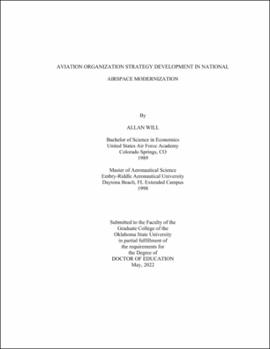| dc.contributor.advisor | Vance, Samuel Matt | |
| dc.contributor.author | Will, Allan | |
| dc.date.accessioned | 2023-03-13T20:47:20Z | |
| dc.date.available | 2023-03-13T20:47:20Z | |
| dc.date.issued | 2022-05 | |
| dc.identifier.uri | https://hdl.handle.net/11244/337087 | |
| dc.description.abstract | The purpose of this qualitative study was to determine how small sub-directorates within larger organizations develop strategy to accomplish expansive legacy infrastructure re-engineering. There is significant, historical academic inquiry on Technological Transitions (TT)s with respect to infrastructure modernization; the conversion of the National Airspace System from ground-based to space-based navigation is an example of a TT. There are also studies on how to re-engineer legacy software systems to continue supporting organizational needs. This study is intended to explore a case of re-engineering the expansive legacy ground-based navigation system in the United States by efficiently reducing the size of the network and expanding then verifying signal coverage on over 4.5 million square miles. It is not a pure TT, nor a pure software re-engineering, but rather a large-scale re-engineering of a pre-existing hardware and software infrastructure. It constitutes a nationwide effort to re-design and expand the legacy ground-based navigation system developed over 70 years. The Federal Aviation Administration (FAA) advised the public in 2011 that it intended to re-engineer and reduce the Very High Frequency Omnidirectional Range (VOR) network from 896 stations down to 593 stations - to be defined as the Minimum Operational Network (MON). This reduction was based on the premise that two-thirds of the legacy VORs would be retained but their coverage expanded to cover twice the airspace within the US than the previous network. The FAA Flight Program Operations (FPO) is a small sub-directorate within the larger organization that is now responsible to validate signal coverage on several million square miles of additional airspace. Understanding how the FPO develops strategy and leverages technology to support this endeavor can provide a repeatable template for future, expansive, legacy infrastructure re-engineering efforts. This study discovered that the FPO developed and iteratively evolved strategy to accomplish the VOR MON using tribal knowledge, subject matter expertise and accepted business re-engineering practices. The template can be applied to other legacy infrastructure re-engineering efforts to support forthcoming TTs. | |
| dc.format | application/pdf | |
| dc.language | en_US | |
| dc.rights | Copyright is held by the author who has granted the Oklahoma State University Library the non-exclusive right to share this material in its institutional repository. Contact Digital Library Services at lib-dls@okstate.edu or 405-744-9161 for the permission policy on the use, reproduction or distribution of this material. | |
| dc.title | Aviation organization strategy development in national airspace modernization | |
| dc.contributor.committeeMember | Bliss, Timm | |
| dc.contributor.committeeMember | Casebolt, Mallory | |
| dc.contributor.committeeMember | Chung, Ryan | |
| dc.contributor.committeeMember | Waters, Craig | |
| osu.filename | Will_okstate_0664D_17546.pdf | |
| osu.accesstype | Open Access | |
| dc.type.genre | Dissertation | |
| dc.type.material | Text | |
| dc.subject.keywords | airspace | |
| dc.subject.keywords | aviation | |
| dc.subject.keywords | infrastructure | |
| dc.subject.keywords | legacy | |
| dc.subject.keywords | modernization | |
| dc.subject.keywords | VOR | |
| dc.subject.keywords | very high frequency omni-directional range | |
| thesis.degree.discipline | Aviation and Space Science | |
| thesis.degree.grantor | Oklahoma State University | |
